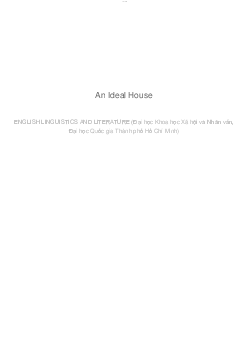



Preview text:
lOMoAR cPSD| 40190299
ILS SB1 U02 Test - Unit test 2_Inside Listening Speaking A2
ENGLISH LINGUISTICS AND LITERATURE (Đại học Khoa học Xã hội và Nhân văn,
Đại học Quốc gia Thành phố Hồ Chí Minh) lOMoAR cPSD| 40190299
Inside Listening and Speaking 1 Unit 2 Assessment
Name: ___________________________________________________ Date: _____________ Part 1 Vocabulary
Circle the best answer to complete each sentence. 1.
Some people use alternative ____ such as acupuncture or yoga to manage pain. A) medical B) participation C) methods 2.
The doctor asked Louise if she wanted to ____ in a clinical trial of the new drug. A) participate B) demonstrate C) process 3.
Developing new drugs to treat some forms of cancer is a very lengthy ____. A) benefit B) process C) method 4.
Drug companies have a ____ requirement to explain any bad side effects of the drugs they sell. A) legal B) methodical C) medical 5.
One of the ____ of being a doctor is the feeling of satisfaction when a patient gets better. A) professions B) processes C) benefits 6.
The patient questioned the ____ of the doctor’s decision to stop her treatment.
Circle the corr ct word form to complete each sent nce. A) legal B) legally C) legality
© Oxford University Press. Permission granted to reproduce for classroom use. 1 lOMoAR cPSD| 40190299
Inside Listening and Speaking 1 Unit 2 Assessment 7.
Hassan’s grandfather eats well and exercises regularly. He has very few ____ problems. A) medicine B) medical C) medically 8.
Monique is a very ____ researcher. She records all her observations and takes careful notes. A) method B) methods
The new drug had a ____ effect on Jeff’s health. He soon had a lot more energy. C) methodical 9. A) demonstrate B) demonstrable C) demonstration 10.
Each ____ in the study took one pill every day. Half took the new drug and half took a sugar pill. A) participate B) participant C) participation
Use five of the words in the box to complete the sentences. benefit demonstrated legally medical methodical participate processed profession 11.
Malika chose nursing as a ________________________ because she enjoys helping people. 12.
In the United States and many other countries, a person is
________________________ dead if he or she loses all brain activity. 13.
After the researchers ________________________ the results of the study, they
had to acknowledge that the drug was not effective. 14.
Initially, Scott felt no ________________________ from taking the drug, but after
a week he noticed an improvement in his health. 15.
As Dr. Alexander Fleming ________________________ with penicillin, some
effective drugs are discovered by accident.
© Oxford University Press. Permission granted to reproduce for classroom use. 2 lOMoAR cPSD| 40190299
Inside Listening and Speaking 1 Unit 2 Assessment Part 2 Listening
Listen to the interview. Circle the best answer to complete each sentence. 16. Why is Dr. Chan in Boston? A)
To give a lecture about diabetes B)
To participate in a conference about diabetes C)
To appear on a program called the Health Report 17. What is insulin? A) A hormone B) A disease C) An organ behind the stomach 18.
How long has diabetes been around? A) After the 1st century B) Since the 1600s C) Before the 16th century BCE 19.
How many people had diabetes in 2000? A) 10 million people B) 170 million people C) 360 million people 20.
About how many adults worldwide have diabetes? A) 9 percent B) 10 percent C) 12 percent
© Oxford University Press. Permission granted to reproduce for classroom use. 3 lOMoAR cPSD| 40190299
Inside Listening and Speaking 1 Unit 2 Assessment
Listen to the lecture again. As you listen, complete the notes. When? (dates) Who? (names) What? (event) 16th century BCE Egyptian and Indian Described symptoms of physicians (21.) ________________ 1st century (22.) ________________ First used the word physician Aretaeus DIABETES 1600s English physician Thomas Noticed high (23.) _________ Willis content in patients (24.) ________________ German scientists Linked diabetes with the pancreas 1921
Canadian (25.) _____________ Discovered insulin Frederick Banting 1922 Scottish scientist John Demonstrated that insulin Macleod
(26.) _______________ patients
Read the sentences about examples. Circle the best answer. 27.
Which question asks for an example? A) Such as? B) What is insulin? 28.
Which phrase gives examples about the number of people with diabetes in 2000 and 2030? A) Like B) For instance 29.
What two factors increase the risk of diabetes? A)
Living in low- and middle-income countries B)
Having a family history and being overweight 30.
What are two examples of lowering the risk of diabetes? A)
Watch your diet and exercise regularly B)
Eat less sugar and see your doctor Part 3 Speaking
Write notes for a one-minute speech about alternative medicine. Then
present your speech to the class.
• Have you ever used alternative medicines, such as herbs or other plants?
• Have you ever tried alternative treatments, such as acupuncture?
• Did alternative medicine help you? If so, explain.
© Oxford University Press. Permission granted to reproduce for classroom use. 4





